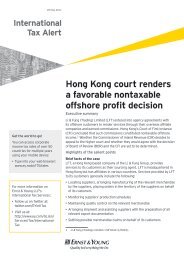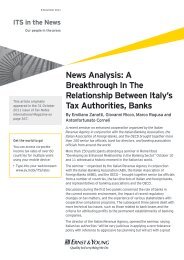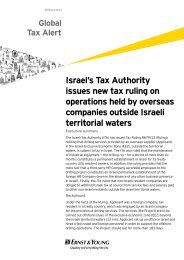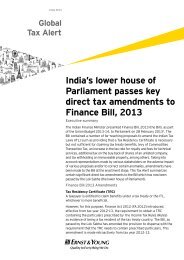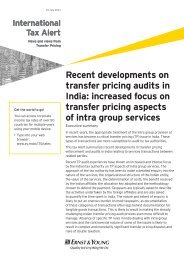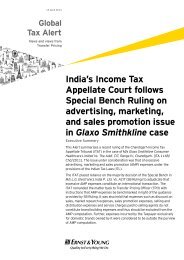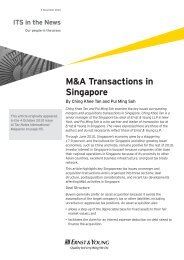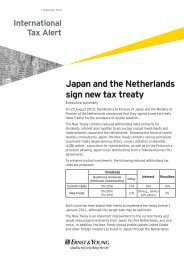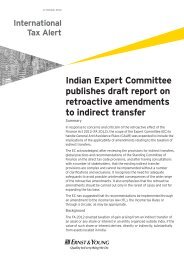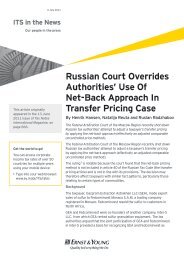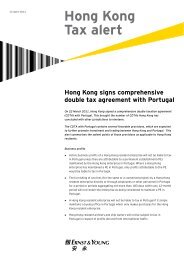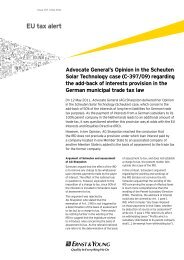(GST) compliance obligations (pdf, 5.62 MB) - Ernst & Young T ...
(GST) compliance obligations (pdf, 5.62 MB) - Ernst & Young T ...
(GST) compliance obligations (pdf, 5.62 MB) - Ernst & Young T ...
You also want an ePaper? Increase the reach of your titles
YUMPU automatically turns print PDFs into web optimized ePapers that Google loves.
Tax administration viewpoint: ways to achieve certainty<br />
Shane Reardon, Deputy Commissioner, Goods and Services<br />
Tax (<strong>GST</strong>) of the Australian Tax Office (ATO), discusses how<br />
the administration is seeking to forge a closer relationship<br />
with large <strong>GST</strong> taxpayers and outlines the potential benefits<br />
for both sides:<br />
“For large corporate taxpayers — I’m talking about taxpayers<br />
with turnover of over A$250 million a year — we offer<br />
what’s called an annual <strong>compliance</strong> arrangement (ACA)<br />
whereby the corporate gets significant benefits from us<br />
in terms of voluntary disclosures and penalty and interest<br />
concessions, speedier turn-around time on advice and<br />
more certainty for the prior year tax position, in return<br />
for a relationship that is based on full and true disclosure.<br />
It is based on the Commissioner being satisfied that<br />
the corporate itself has good tax risk management and<br />
governance processes in place as a matter of course and<br />
that we are satisfied with those governance processes.<br />
For example, the corporate would alert their board or the<br />
management to major tax issues as a matter of course.<br />
In return, we would adopt a relationship that isn’t based<br />
on audit, but is based on an assurance-based process,<br />
knowing that the taxpayer will disclose any issues to us. On<br />
that basis, we would work together to resolve any issues<br />
and reach agreement on the tax treatment and this would<br />
include concessions when it came to penalties and interest.<br />
Full and true disclosure also operates the other way so<br />
the Tax Office would be required to provide disclosure of<br />
information that was relevant to the corporate as well — for<br />
example, we would inform the corporate of any emerging<br />
<strong>GST</strong> risks and issues that would apply to their relevant<br />
market or industry.”<br />
“Entering into the arrangement is subject to <strong>compliance</strong><br />
history but this has really moved on from our point of<br />
view. Two or three years ago, we would conduct a full and<br />
very comprehensive review of all the corporate’s systems<br />
and processes and satisfy ourselves that there was a good<br />
culture of <strong>compliance</strong>. We’ve relaxed that a fair bit and the<br />
Commissioner will now accept a letter from the CFO or<br />
CEO on behalf of the board attesting that there are good<br />
systems and processes in place that support a sound tax<br />
risk management framework within the overall corporate<br />
governance framework.”<br />
35 VAT and <strong>GST</strong>: multiple burdens for multinational companies<br />
“We then appoint a relationship manager to work with<br />
someone from the corporate, generally from their tax<br />
management area or their tax unit. For the annual<br />
<strong>compliance</strong> arrangements we’ve got in place, there is<br />
basically pretty consistent dialogue and exchange between<br />
the corporate and the Tax Office. These exchanges<br />
occur not in an audit environment but in a relationship<br />
environment. We’ve only got a handful of taxpayers who<br />
have signed up to this arrangement for the moment so we<br />
are still working through some issues around marketing<br />
and implementation but, generally, the taxpayers who are<br />
involved are actually quite satisfied with the arrangement<br />
and believe it does represent value.”<br />
“There are also advantages for the tax administration of<br />
having this kind of relationship with taxpayers. It allows<br />
us to focus our resources more effectively. It is a long way<br />
from the ‘hide and seek’ relationship of the past. Of course,<br />
we still examining issues and transactions, and we monitor<br />
<strong>compliance</strong> at a macro level pretty well. The audit program<br />
is a significant part of what we do, but we also know that<br />
on its own, it will not get us to where we want to go.”<br />
“We want to create an environment where corporates<br />
can easily do the right thing and meet their <strong>obligations</strong>.<br />
That is the advantage that the ACA gives. It is built on<br />
a mutual trust. Because we’ve got a letter from their<br />
CEO or CFO we trust they’ve got good systems in place,<br />
we trust that they’re going to fully disclose to us issues<br />
that they should and equally they trust that we’ll keep<br />
our word in terms of disclosing issues to them, providing<br />
certainty, delivering high quality and timely service and<br />
also providing the concessionary approaches when it<br />
comes to interest, penalties and the treatment of mistakes.<br />
One ACA participant was contemplating a transaction and<br />
treating it a certain way; they talked to us upfront about<br />
it, we gave them advice and they treated the transaction<br />
in accordance with our advice, which they might not have<br />
done without the ACA. This lets us focus on making the<br />
open relationship environment very real and tangible,<br />
where corporates are given the right advice at the right<br />
time and the transparency of the relationship is strong, and<br />
we can be assured that the <strong>GST</strong> revenues are being paid as<br />
they should be paid.”



